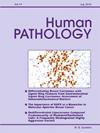侵袭性乳腺癌her2超低表达的分子和临床病理特征
IF 2.7
2区 医学
Q2 PATHOLOGY
引用次数: 0
摘要
在her2靶向抗体-药物偶联物(adc)的临床疗效得到证实后,her2低和her2超低乳腺癌(BC)亚群的鉴定引起了相当大的关注。本研究调查了与her2未检测到的肿瘤相比,这些亚组是否代表不同的生物学亚型。通过免疫组织化学分层分析297例her2阴性bc (50.2% her2低,35.7% her2超低,14.1% her2未检测),我们系统地比较了临床病理和分子特征(AmoyDx®HANDLE经典小组)。her2检测到的肿瘤(联合低/超低队列)与her2未检测到的肿瘤在激素受体(HR)阳性方面存在显著差异(p = 0.001)。her2超低肿瘤中三个最常改变的基因(TP53, PIK3CA和PTEN)的突变频率与其他两个亚组没有显著差异。然而,与未检测到her2的肿瘤相比,检测到her2的肿瘤表现出不同的分子改变,前者PIK3CA突变增加(p = 0.024),后者TP53突变富集(p = 0.007)。当根据HR状态对肿瘤进行分层时,这些差异减弱。此外,HER2表达与ERBB2拷贝数呈正相关,HER2检测亚组的平均值高于未检测亚组(2.01±0.31 vs 1.88±0.23;p = 0.011)。虽然亚组间生存率无显著差异,但大多数死亡事件发生在her2低(6/12,50.0%)和her2超低(5/12,41.7%)病例中。我们的研究结果表明,虽然her2低和her2超低乳腺癌可能不代表独立的生物学亚型,但由于潜在的ADC治疗意义,它们与her2未检测到的肿瘤的临床区别仍然至关重要。本文章由计算机程序翻译,如有差异,请以英文原文为准。
Molecular and clinicopathological characteristics of invasive breast cancers with HER2-ultralow expression
The identification of HER2-low and HER2-ultralow breast cancer (BC) subgroups has garnered considerable attention following the demonstrated clinical efficacy of HER2-targeted antibody-drug conjugates (ADCs). This study investigated whether these subgroups represent distinct biological subtypes compared to HER2-undetected tumors. Analyzing 297 HER2-negative BCs stratified by immunohistochemistry (50.2 % HER2-low, 35.7 % HER2-ultralow, 14.1 % HER2-undetected), we systematically compared clinicopathological and molecular profiles (AmoyDx® HANDLE Classic Panel). HER2-detected tumors (combined low/ultralow cohort) showed significant differences in hormone receptor (HR) positivity versus HER2-undetected tumors (p = 0.001). The mutation frequencies of the three most frequently altered genes (TP53, PIK3CA, and PTEN) in HER2-ultralow tumors did not significantly differ from those in the two other subgroups. However, HER2-detected tumors exhibited different molecular alterations compared to HER2-undetected tumors, with increased PIK3CA mutations in the former (p = 0.024) and TP53 mutation enrichment in the latter (p = 0.007). These differences attenuated when tumors were stratified by HR status. In addition, HER2 expression positively correlated with ERBB2 copy number, showing higher mean values in HER2-detected subgroups versus undetected counterparts (2.01 ± 0.31 vs 1.88 ± 0.23; p = 0.011). While no significant survival differences emerged across subgroups, most mortality events occurred in HER2-low (6/12, 50.0 %) and HER2-ultralow (5/12, 41.7 %) cases. Our findings indicate that while HER2-low and HER2-ultralow breast cancers may not represent independent biological subtypes, their clinical distinction from HER2-undetected tumors remains crucial due to potential ADC therapeutic implications.
求助全文
通过发布文献求助,成功后即可免费获取论文全文。
去求助
来源期刊

Human pathology
医学-病理学
CiteScore
5.30
自引率
6.10%
发文量
206
审稿时长
21 days
期刊介绍:
Human Pathology is designed to bring information of clinicopathologic significance to human disease to the laboratory and clinical physician. It presents information drawn from morphologic and clinical laboratory studies with direct relevance to the understanding of human diseases. Papers published concern morphologic and clinicopathologic observations, reviews of diseases, analyses of problems in pathology, significant collections of case material and advances in concepts or techniques of value in the analysis and diagnosis of disease. Theoretical and experimental pathology and molecular biology pertinent to human disease are included. This critical journal is well illustrated with exceptional reproductions of photomicrographs and microscopic anatomy.
 求助内容:
求助内容: 应助结果提醒方式:
应助结果提醒方式:


